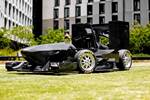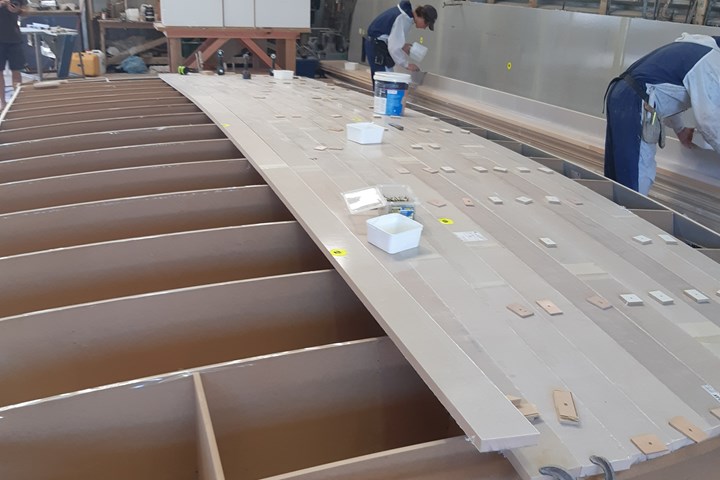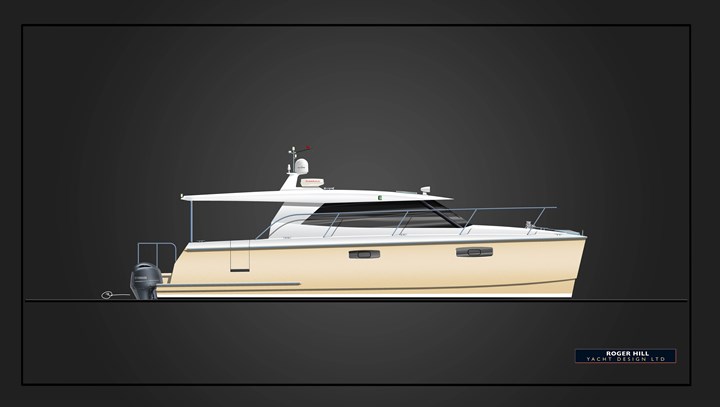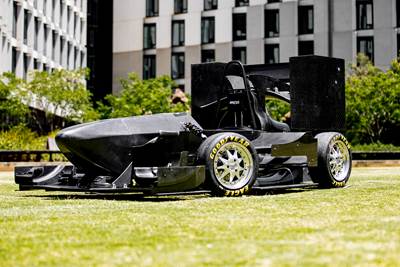Celeste is an under-construction, 12-meter power catamaran designed by Roger Hill and built by boatbuilder Grant Symmans at G&T Marine (Auckland, New Zealand). The privately owned, custom-built, displacement hull power cat is said to be on track for a May 2023 delivery, thanks in part to the ease of assembly with ATL Composites’ (Molendinar, Australia) composite DuFLEX panels and Z-press system. The vessel is a single-level sedan with a beam of 4.8 meters — a “fairly straightforward” build, Symmans notes.
Symmans was accustomed to traditional materials like plywood, timber and fiberglass skins, but says he was intrigued by the reported benefits of DuFLEX like its precise cut, time and labor savings and minimal waste. In addition, boat designer Roger Hill had used the technology before and recommended it for the project. Symmans notes that the preliminary design for Celeste was based on standard, foam-cored composite boatbuilding methods like infusion, and that DuFLEX ended up being the most cost-effective option. “It’s a first for me. It’s labor-saving, comes as a kit and the DuFLEX is light and sturdy,” he says.
DuFLEX panels are lightweight, prefabricated custom panels that are constructed from E-glass reinforcement, epoxy and a balsa or foam core. For Celeste, DuFLEX panels are used for the superstructure, cabin top and hulls. The hull bottom comprises 20-millimeter H100 DuFLEX strips made from 460-gsm unidirectional (UD) E-glass cored with Divinycell foam from Diab (Laholm, Sweden). The hull sides are laminated with 800-gsm quadraxial E-glass and Divinycell core to meet performance and engineering requirements.
Specifically designed to reduce construction time, DuFLEX panels are delivered ready to assemble, either manually with an adhesive or with the aid of ATL Composites’ Z-press. Using ATL’s Z-Press streamlines the composite panel joining process, applying heat and pressure to cure the epoxy adhesive on Z-joints pre-machined into the panels. Joints cure fully in seven to 20 minutes, depending on the ambient temperature, type of hardener, core type and thickness of the panel.
“Using DuFLEX has made construction a simple process, and at this stage we’re impressed with it,” Symmans says.
Roger Hill, specialist power multihull designer, says the client was a previous yacht owner who sought a well-appointed power catamaran for “the next phase of his cruising lifestyle.” He notes that displacement hull catamarans “cruise most economically around 14 to 15 knots, or about twice the speed [yacht owners] have been used to going all of [their] previous boating life, and they are really fuel efficient.”
The catamaran is a standard design with a few unique features such as a swimming dive platform that lowers down to form steps and a launching platform for a rigid inflatable boat (RIB).
The decision to use the DuFLEX system was made when the client saw it for himself, visiting the 16-meter Omahu and speaking to its owner who had a previous sailing cat built out of DuFLEX and was positive about the process. “The client, whose father was a New Zealand timber boatbuilder and built many cold-molded Kauri sailing yachts, was quite tentative about the process but is now also becoming much more relaxed and happy as he sees the boat coming to life.”
Related Content
Infinite Composites: Type V tanks for space, hydrogen, automotive and more
After a decade of proving its linerless, weight-saving composite tanks with NASA and more than 30 aerospace companies, this CryoSphere pioneer is scaling for growth in commercial space and sustainable transportation on Earth.
Read MoreCarbon fiber in pressure vessels for hydrogen
The emerging H2 economy drives tank development for aircraft, ships and gas transport.
Read MorePrice, performance, protection: EV battery enclosures, Part 1
Composite technologies are growing in use as suppliers continue efforts to meet more demanding requirements for EV battery enclosures.
Read MoreNovel dry tape for liquid molded composites
MTorres seeks to enable next-gen aircraft and open new markets for composites with low-cost, high-permeability tapes and versatile, high-speed production lines.
Read MoreRead Next
Monash Motorsport constructs FSAE autonomous, electric vehicle with ATL Composites materials
Composite are incorporated into the vehicle’s monocoque chassis, aerofoils, aerofoil endplates and other components to suit high aerodynamic loads, minimize mass and enhance efficiency for the globally competitive team.
Read MoreComposite panels aid design of prefabricated apartment addition
Glass fiber/epoxy sandwich panels achieved structural requirements, complex geometries and challenging installation needs for London apartment renovation.
Read MoreFrom the CW Archives: The tale of the thermoplastic cryotank
In 2006, guest columnist Bob Hartunian related the story of his efforts two decades prior, while at McDonnell Douglas, to develop a thermoplastic composite crytank for hydrogen storage. He learned a lot of lessons.
Read More

.jpg;width=70;height=70;mode=crop)




























